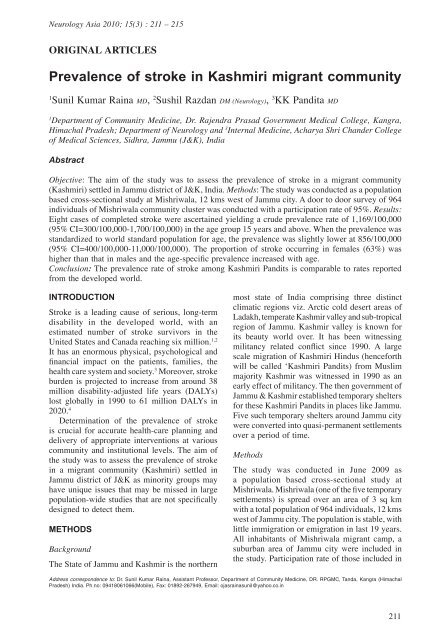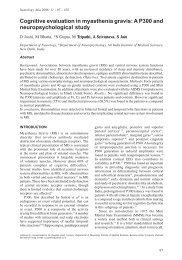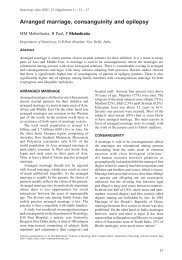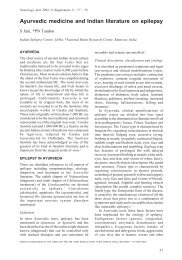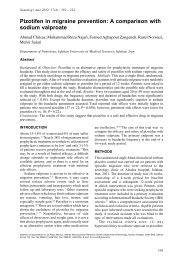Prevalence of stroke in Kashmiri migrant community - Neurology Asia
Prevalence of stroke in Kashmiri migrant community - Neurology Asia
Prevalence of stroke in Kashmiri migrant community - Neurology Asia
Create successful ePaper yourself
Turn your PDF publications into a flip-book with our unique Google optimized e-Paper software.
<strong>Neurology</strong> <strong>Asia</strong> 2010; 15(3) : 211 – 215<br />
ORIGINAL ARTICLES<br />
<strong>Prevalence</strong> <strong>of</strong> <strong>stroke</strong> <strong>in</strong> <strong>Kashmiri</strong> <strong>migrant</strong> <strong>community</strong><br />
1 Sunil Kumar Ra<strong>in</strong>a MD, 2 Sushil Razdan DM (<strong>Neurology</strong>), 3 KK Pandita MD<br />
1 Department <strong>of</strong> Community Medic<strong>in</strong>e, Dr. Rajendra Prasad Government Medical College, Kangra,<br />
Himachal Pradesh; Department <strong>of</strong> <strong>Neurology</strong> and 3 Internal Medic<strong>in</strong>e, Acharya Shri Chander College<br />
<strong>of</strong> Medical Sciences, Sidhra, Jammu (J&K), India<br />
Abstract<br />
Objective: The aim <strong>of</strong> the study was to assess the prevalence <strong>of</strong> <strong>stroke</strong> <strong>in</strong> a <strong>migrant</strong> <strong>community</strong><br />
(<strong>Kashmiri</strong>) settled <strong>in</strong> Jammu district <strong>of</strong> J&K, India. Methods: The study was conducted as a population<br />
based cross-sectional study at Mishriwala, 12 kms west <strong>of</strong> Jammu city. A door to door survey <strong>of</strong> 964<br />
<strong>in</strong>dividuals <strong>of</strong> Mishriwala <strong>community</strong> cluster was conducted with a participation rate <strong>of</strong> 95%. Results:<br />
Eight cases <strong>of</strong> completed <strong>stroke</strong> were ascerta<strong>in</strong>ed yield<strong>in</strong>g a crude prevalence rate <strong>of</strong> 1,169/100,000<br />
(95% CI=300/100,000-1,700/100,000) <strong>in</strong> the age group 15 years and above. When the prevalence was<br />
standardized to world standard population for age, the prevalence was slightly lower at 856/100,000<br />
(95% CI=400/100,000-11,000/100,000). The proportion <strong>of</strong> <strong>stroke</strong> occurr<strong>in</strong>g <strong>in</strong> females (63%) was<br />
higher than that <strong>in</strong> males and the age-specifi c prevalence <strong>in</strong>creased with age.<br />
Conclusion: The prevalence rate <strong>of</strong> <strong>stroke</strong> among <strong>Kashmiri</strong> Pandits is comparable to rates reported<br />
from the developed world.<br />
INTRODUCTION<br />
Stroke is a lead<strong>in</strong>g cause <strong>of</strong> serious, long-term<br />
disability <strong>in</strong> the developed world, with an<br />
estimated number <strong>of</strong> <strong>stroke</strong> survivors <strong>in</strong> the<br />
United States and Canada reach<strong>in</strong>g six million. 1,2<br />
It has an enormous physical, psychological and<br />
fi nancial impact on the patients, families, the<br />
health care system and society. 3 Moreover, <strong>stroke</strong><br />
burden is projected to <strong>in</strong>crease from around 38<br />
million disability-adjusted life years (DALYs)<br />
lost globally <strong>in</strong> 1990 to 61 million DALYs <strong>in</strong><br />
2020. 4<br />
Determ<strong>in</strong>ation <strong>of</strong> the prevalence <strong>of</strong> <strong>stroke</strong><br />
is crucial for accurate health-care plann<strong>in</strong>g and<br />
delivery <strong>of</strong> appropriate <strong>in</strong>terventions at various<br />
<strong>community</strong> and <strong>in</strong>stitutional levels. The aim <strong>of</strong><br />
the study was to assess the prevalence <strong>of</strong> <strong>stroke</strong><br />
<strong>in</strong> a <strong>migrant</strong> <strong>community</strong> (<strong>Kashmiri</strong>) settled <strong>in</strong><br />
Jammu district <strong>of</strong> J&K as m<strong>in</strong>ority groups may<br />
have unique issues that may be missed <strong>in</strong> large<br />
population-wide studies that are not specifi cally<br />
designed to detect them.<br />
METHODS<br />
Background<br />
The State <strong>of</strong> Jammu and Kashmir is the northern<br />
most state <strong>of</strong> India compris<strong>in</strong>g three dist<strong>in</strong>ct<br />
climatic regions viz. Arctic cold desert areas <strong>of</strong><br />
Ladakh, temperate Kashmir valley and sub-tropical<br />
region <strong>of</strong> Jammu. Kashmir valley is known for<br />
its beauty world over. It has been witness<strong>in</strong>g<br />
militancy related confl ict s<strong>in</strong>ce 1990. A large<br />
scale migration <strong>of</strong> <strong>Kashmiri</strong> H<strong>in</strong>dus (henceforth<br />
will be called ‘<strong>Kashmiri</strong> Pandits) from Muslim<br />
majority Kashmir was witnessed <strong>in</strong> 1990 as an<br />
early effect <strong>of</strong> militancy. The then government <strong>of</strong><br />
Jammu & Kashmir established temporary shelters<br />
for these <strong>Kashmiri</strong> Pandits <strong>in</strong> places like Jammu.<br />
Five such temporary shelters around Jammu city<br />
were converted <strong>in</strong>to quasi-permanent settlements<br />
over a period <strong>of</strong> time.<br />
Methods<br />
The study was conducted <strong>in</strong> June 2009 as<br />
a population based cross-sectional study at<br />
Mishriwala. Mishriwala (one <strong>of</strong> the fi ve temporary<br />
settlements) is spread over an area <strong>of</strong> 3 sq km<br />
with a total population <strong>of</strong> 964 <strong>in</strong>dividuals, 12 kms<br />
west <strong>of</strong> Jammu city. The population is stable, with<br />
little immigration or emigration <strong>in</strong> last 19 years.<br />
All <strong>in</strong>habitants <strong>of</strong> Mishriwala <strong>migrant</strong> camp, a<br />
suburban area <strong>of</strong> Jammu city were <strong>in</strong>cluded <strong>in</strong><br />
the study. Participation rate <strong>of</strong> those <strong>in</strong>cluded <strong>in</strong><br />
Address correspondence to: Dr. Sunil Kumar Ra<strong>in</strong>a, Assistant Pr<strong>of</strong>essor, Department <strong>of</strong> Community Medic<strong>in</strong>e, DR. RPGMC, Tanda, Kangra (Himachal<br />
Pradesh) India. Ph.no: 09418061066(Mobile), Fax: 01892-267949, Email: ojasra<strong>in</strong>asunil@yahoo.co.<strong>in</strong><br />
211
<strong>Neurology</strong> <strong>Asia</strong> December 2010<br />
the study was 95% and a total <strong>of</strong> 916 <strong>in</strong>dividuals<br />
participated. The high participation was partly due<br />
to a door to door campaign <strong>in</strong> the area expla<strong>in</strong><strong>in</strong>g<br />
the study one week prior to the date <strong>of</strong> survey.<br />
Earlier we reported on the prevalence <strong>of</strong> dementia<br />
among <strong>Kashmiri</strong> Pandits from the same area. 5<br />
The study was conducted as door to door survey<br />
cover<strong>in</strong>g whole <strong>of</strong> Mishriwala cluster. Dur<strong>in</strong>g<br />
the fi rst phase, data was collected by the Survey<br />
Team compris<strong>in</strong>g <strong>of</strong> an Epidemiologist assisted<br />
by Medical Students from our Institute.<br />
The Survey Team was tra<strong>in</strong>ed <strong>in</strong> the detection<br />
<strong>of</strong> neurological compla<strong>in</strong>ts and <strong>in</strong> complet<strong>in</strong>g a<br />
screen<strong>in</strong>g questionnaire. The questionnaire was<br />
written <strong>in</strong> local vernacular prepared <strong>in</strong> accordance<br />
with the WHO protocol for measur<strong>in</strong>g the<br />
prevalence <strong>of</strong> neurological disorders <strong>in</strong> develop<strong>in</strong>g<br />
countries. 6 The process was similar to the one<br />
used <strong>in</strong> an earlier study conducted on ethnically<br />
similar population by one <strong>of</strong> the contributors<br />
to this study. 7 A written <strong>in</strong>formed consent was<br />
obta<strong>in</strong>ed prior to conduct <strong>of</strong> survey.<br />
The questionnaire was adm<strong>in</strong>istered to all<br />
family members and the demographic details<br />
were collected from all families, preferably from<br />
the head <strong>of</strong> the household or reliable <strong>in</strong>formant<br />
dur<strong>in</strong>g house-to-house survey. The Cl<strong>in</strong>ical Team<br />
compris<strong>in</strong>g <strong>of</strong> a Neurologist and a Physician<br />
assisted by an Epidemiologist, who subsequently<br />
<strong>in</strong>terviewed and exam<strong>in</strong>ed all suspected cases <strong>in</strong><br />
their home sett<strong>in</strong>gs.<br />
The records <strong>of</strong> cl<strong>in</strong>ical data were verifi ed by the<br />
Physician and Epidemiologist for completeness <strong>of</strong><br />
data collection. The previous <strong>in</strong>vestigations, e.g.,<br />
EEG and neuroimag<strong>in</strong>g; details <strong>of</strong> prescription<br />
and compliance were also noted dur<strong>in</strong>g this phase.<br />
Patients were asked their regular occupation or, if<br />
they were retired, their last full time occupation.<br />
Women were assigned their own occupation, with<br />
the exception <strong>of</strong> housewives, who were assigned<br />
their husbands or father’s occupation. This was<br />
done purely for the calculation <strong>of</strong> socio-economic<br />
status <strong>of</strong> the family.<br />
Classifi cation <strong>of</strong> pathological <strong>stroke</strong> type was<br />
not done as full <strong>in</strong>vestigative details were not<br />
available from all the patients.<br />
Validation <strong>of</strong> questionnaires<br />
The validity <strong>of</strong> screen<strong>in</strong>g questionnaire was<br />
carried out <strong>in</strong> a pilot study among 50 subjects.<br />
They were exam<strong>in</strong>ed by the cl<strong>in</strong>ical Team<br />
aga<strong>in</strong> to look for the false positive and false<br />
negative cases. On the basis <strong>of</strong> the pilot study,<br />
the questionnaire was found to have sensitivity<br />
<strong>of</strong> 94% and specifi city <strong>of</strong> 92%.<br />
212<br />
Diagnostic criteria<br />
Stroke was defi ned as a rapidly develop<strong>in</strong>g cl<strong>in</strong>ical<br />
syndrome <strong>of</strong> focal (or global) disturbance <strong>of</strong><br />
cerebral function, with symptoms last<strong>in</strong>g 24h or<br />
longer or lead<strong>in</strong>g to death, with no apparent cause<br />
other than due to vascular orig<strong>in</strong>. 1 Only <strong>stroke</strong><br />
survivors were <strong>in</strong>cluded <strong>in</strong> this study.<br />
RESULTS<br />
Demographic data<br />
For the 916 screened subjects, those over 15 years<br />
<strong>of</strong> age represented 74% <strong>of</strong> the population (Table 1).<br />
This was much higher than the national average. 8<br />
The sex distribution <strong>in</strong> the study population was<br />
almost equal between both genders, with men<br />
slightly more <strong>in</strong> number (51.2%). The age-sex<br />
characteristic <strong>of</strong> study population is shown <strong>in</strong><br />
Table 1.<br />
The distribution and prevalence rate <strong>of</strong> <strong>stroke</strong><br />
is shown <strong>in</strong> Table 2. Eight cases <strong>of</strong> completed<br />
<strong>stroke</strong> were found yield<strong>in</strong>g a crude prevalence<br />
rate <strong>of</strong> 1,169/100,000 <strong>in</strong> the age group 15 years<br />
and above. The proportion <strong>of</strong> <strong>stroke</strong> occurr<strong>in</strong>g <strong>in</strong><br />
females (63%) was higher than that <strong>in</strong> males.<br />
A prevalence rate <strong>of</strong> 3,947/100,000 was found<br />
<strong>in</strong> population 70 years and above. The age-specifi c<br />
prevalence <strong>in</strong>creased with age. Our prevalence<br />
rates are almost similar to the rates <strong>in</strong> developed<br />
world. 9-11 When the prevalence was standardized to<br />
world standard population12 for age; the prevalence<br />
was slightly lower at 856/100,000.<br />
DISCUSSION<br />
The worldwide prevalence rate for cerebrovascular<br />
disease is between 500 and 700/100,000<br />
population 9-11 the crude prevalence rate <strong>of</strong><br />
1,169/100,000 and standardized prevalence<br />
rate <strong>of</strong> 856/100,000 for <strong>stroke</strong> among <strong>Kashmiri</strong><br />
<strong>migrant</strong>s is similar to <strong>in</strong>ternational averages. The<br />
exponential <strong>in</strong>crease <strong>in</strong> prevalence <strong>of</strong> completed<br />
<strong>stroke</strong> with age preponderance <strong>in</strong> this study is also<br />
compatible with the <strong>in</strong>ternational data.<br />
Earlier studies show a marked difference <strong>in</strong><br />
the prevalence rate between various countries<br />
and across communities with<strong>in</strong> the same nation.<br />
For example, <strong>in</strong> India the reported crude <strong>stroke</strong><br />
prevalence varied from 57/100,000 <strong>in</strong> Vellore<br />
(southern India) 13 , 45/100,000 <strong>in</strong> Rohtak (northern<br />
India) 14 , 147/100,000 <strong>in</strong> Kolkata (eastern India) 15 ,<br />
222/100,000 among H<strong>in</strong>dus <strong>in</strong> Bombay (western<br />
India) 16 , to 843/100,000 <strong>in</strong> Bombay’s Parsi<br />
<strong>community</strong>. 17 There was also a difference between<br />
our results and previous study among shepherds
Table 1: Demographic pr<strong>of</strong>ile <strong>of</strong> study population (Mishriwala)<br />
Age (yrs) Sex<br />
Male Female Total<br />
0-9 85 (18.1) 83 (18.5) 168 (18.3)<br />
10-19 77 (16.4) 74 (16.5) 151 (16.4)<br />
20-29 69 (14.7) 68 (15.2) 137 (14.9)<br />
30-39 62 (13.2) 56 (12.5) 118 (12.8)<br />
40-49 49 (10.4) 46 (10.2) 95 (10.3)<br />
50-59 41 (8.7) 37 (8.2) 78 (8.5)<br />
60-69 49 (10.4) 44 (9.8) 93 (10.1)<br />
> 70 37 (7.8) 39 (8.7) 76 (8.2)<br />
Total 469 (100) 447 (100) 916 (100)<br />
Figures <strong>in</strong> parenthesis are percentages.<br />
Female: Male = 953 : 1000<br />
and cultivators <strong>in</strong> the rural Kashmir. 5 The study<br />
was conducted prior to 1990. The prevalence was<br />
lower at 143/100,000.<br />
Accord<strong>in</strong>g to our estimates, prevalence <strong>of</strong><br />
<strong>stroke</strong> <strong>in</strong> study population is higher <strong>in</strong> females,<br />
with 63% <strong>of</strong> the <strong>stroke</strong> subjects be<strong>in</strong>g women.<br />
Among women, the prevalence appears to fall <strong>in</strong><br />
70+ age group, but the number <strong>of</strong> cases is very<br />
small. The higher prevalence among women<br />
seen <strong>in</strong> our study among the <strong>migrant</strong> <strong>Kashmiri</strong><br />
population may be expla<strong>in</strong>ed by: 1) that women<br />
develop <strong>stroke</strong> at a later age than do men, as<br />
observed <strong>in</strong> Spanish studies 18,19 ; 2) that male <strong>stroke</strong><br />
sufferers have worse survival prospects than their<br />
female counterparts; and 3) that such sex-selective<br />
survival is particularly evident at very old ages.<br />
S<strong>in</strong>ce the latter two statements have not been<br />
empirically supported by the results <strong>of</strong> European<br />
studies, <strong>in</strong> which age-adjusted case-fatality rates<br />
were higher among women than among men 20,21 ,<br />
the pattern <strong>of</strong> <strong>stroke</strong> <strong>in</strong> Mishriwala might be<br />
expla<strong>in</strong>ed by the effect <strong>of</strong> differential <strong>in</strong>cidence<br />
traits <strong>in</strong> the two sexes.<br />
Table 2: Distribution and prevalence rates for completed <strong>stroke</strong> <strong>in</strong> Mishriwala, <strong>migrant</strong> camp<br />
Age Distribution <strong>Prevalence</strong> rate/100,000<br />
Years Total Males Females Total Males Females<br />
N n N n N n Rate Rate Rate<br />
15-19 87 -- 42 -- 45 -- -- -- --<br />
20-29 137 1 69 -- 68 1 720 -- 1,470<br />
30-39 118 -- 62 -- 56 -- -- -- --<br />
40-49 95 -- 49 -- 46 -- -- -- --<br />
50-59 78 1 41 -- 37 1 1,282 -- 2,702<br />
60-69 93 3 49 1 44 2 3,225 2,040 4,545<br />
70+ 76 3 37 2 39 1 3,947 5,405 2,564<br />
Total 684 8 349 3 335 5 1,169 859 1,492<br />
Crude prevalence rate: 1169/100,000 (95% CI=300/100,000-1700/100,000)<br />
Standardized <strong>Prevalence</strong> Rate: 856/100,000 (95% CI=400/100,000-1,100/100,000)<br />
213
<strong>Neurology</strong> <strong>Asia</strong> December 2010<br />
The strength <strong>of</strong> this study was that a formal<br />
<strong>in</strong>strument written <strong>in</strong> the local vernacular language<br />
was used <strong>in</strong> the survey, with tra<strong>in</strong><strong>in</strong>g <strong>of</strong> the Survey<br />
Team. However, the number <strong>of</strong> <strong>stroke</strong> subjects<br />
detected was small, affect<strong>in</strong>g the determ<strong>in</strong>ation<br />
<strong>of</strong> the prevalence.” Nevertheless we believe that<br />
the data from this study is <strong>in</strong>valuable as it was<br />
the fi rst ever <strong>stroke</strong> prevalence study among the<br />
<strong>Kashmiri</strong> <strong>migrant</strong>s population. Stroke prevalence<br />
for ethnic <strong>Kashmiri</strong> population, <strong>in</strong>clud<strong>in</strong>g <strong>migrant</strong>s<br />
after 1990 (the year when confl ict started) is<br />
scarce. Future <strong>stroke</strong> studies should <strong>in</strong>corporate<br />
the knowledge, understand<strong>in</strong>g and attitude <strong>of</strong><br />
the patients as well as general public. Age<strong>in</strong>g <strong>of</strong><br />
the Indian population suggests that the burden<br />
<strong>of</strong> <strong>stroke</strong> <strong>in</strong> India will <strong>in</strong>crease, thus call<strong>in</strong>g for<br />
more research on <strong>stroke</strong>.<br />
REFERENCES<br />
1. www.americanheart.org<br />
2. www.heartand<strong>stroke</strong>.ca<br />
3. Feig<strong>in</strong> VL, Barker-Collo S, McNaughton H, Brown<br />
P, Kerse N. Long-term neuropsychological and<br />
functional outcomes <strong>in</strong> <strong>stroke</strong> survivors: current<br />
evidence and perspectives for new research.<br />
214<br />
AFGHANISTAN<br />
ARABIAN SEA<br />
PAKISTAN<br />
MUMBAI<br />
JAMMU &<br />
KASHMIR<br />
DELHI<br />
HYDERABAD<br />
SRI LANKA<br />
Location <strong>of</strong><br />
Jammu & Kashmir <strong>in</strong> India<br />
NEPAL<br />
BANGALORE CHENNAI<br />
(MADRAS)<br />
CHINA<br />
TIBET<br />
BHUTAN<br />
BANGLADESH<br />
CALCUTTA<br />
BAY OF BENGAL<br />
MYANMAR<br />
(BURMA)<br />
LOAS<br />
THAILAND<br />
International J Stoke 2008; 3(1): 33-40.<br />
4. Mackay J, Mensah, GA. The atlas <strong>of</strong> heart disease<br />
and <strong>stroke</strong>. Geneva: World Health Organization, 2004.<br />
5. Ra<strong>in</strong>a S, Razdan S, Pandita KK, Ra<strong>in</strong>a S. <strong>Prevalence</strong><br />
<strong>of</strong> dementia among <strong>Kashmiri</strong> <strong>migrant</strong>s. Ann Indian<br />
Acad Neurol 2008; 11:106-8<br />
6. World Health Organization: Research protocol for<br />
measur<strong>in</strong>g the prevalence <strong>of</strong> neurological disorders<br />
<strong>in</strong> develop<strong>in</strong>g countries. Neurosciences Programme,<br />
Geneva 1981.<br />
7. Razdan S, Koul RL, Motta A, Kaul S. Cerebrovascular<br />
disease <strong>in</strong> rural Kashmir, India. Stroke 1989; 20:<br />
1691-3.<br />
8. Park K. Demography and family plann<strong>in</strong>g. Park’s<br />
textbook <strong>of</strong> preventive and social medic<strong>in</strong>e, 20 th ed.<br />
Jabalpur; M/s Banarsidas Bhanot Publishers: 2009<br />
411-47.<br />
9. Kurtzke JF: Epidemiology <strong>of</strong> cerebrovascular disease.<br />
In: Siekert RG, ed: Cerebrovascular survey report<br />
for Jo<strong>in</strong>t Council Subcommittee on Cerebrovascular<br />
Disease. National Institute <strong>of</strong> Neurological and<br />
Communicative Disorders and Stroke and National<br />
Heart and Lung Institute. Rochester, M<strong>in</strong>n, Whit<strong>in</strong>g<br />
Press, 1980, Vol 5, 135-76.<br />
10. Kurtzke JF. The current neurologic burden <strong>of</strong> illness<br />
and <strong>in</strong>jury <strong>in</strong> the United States. <strong>Neurology</strong> 1982;<br />
32:1207-14.<br />
11. Sivenius J, Riekk<strong>in</strong>en P, Pyorala K, He<strong>in</strong>onen O.<br />
Epidemiology <strong>of</strong> <strong>stroke</strong> <strong>in</strong> the Kuopio area, F<strong>in</strong>land
(abstract), <strong>in</strong> Twelfth World Congress <strong>of</strong> <strong>Neurology</strong>.<br />
International Congress Series 548. Amsterdam.<br />
Excerpta Medica 1981; 31.<br />
12. Ahmad O, Boschi-P<strong>in</strong>ton C, Lopez AD, Murray<br />
CJL, Lozano R, Inoue M. Age standardization <strong>of</strong><br />
rates: a new WHO standard. Geneva, World Health<br />
organization, 2001.<br />
13. Sunder Rao PSS. Some aspects <strong>of</strong> epidemiology <strong>of</strong><br />
<strong>stroke</strong> <strong>in</strong> South India. In: Abraham J, ed: Proceed<strong>in</strong>gs<br />
<strong>of</strong> the First AU Indian Workshop-Conference on<br />
Stroke. New Delhi, Indian Council <strong>of</strong> Medical<br />
Research, 1973, 27-33<br />
14. Anand K, Chowdhury D, S<strong>in</strong>gh KB, Pandav CS,<br />
Kapoor SK. Estimation <strong>of</strong> mortality and morbidity<br />
due to <strong>stroke</strong>s <strong>in</strong> India. Neuroepidemiology 2001;<br />
20: 208-11.<br />
15. Banerjee TK, Mukherjee CS, Sarkhel A. Stroke <strong>in</strong><br />
theurban population <strong>of</strong> Calcutta – an epidemiological<br />
study. Neuroepidemiology 2001; 20: 201-7.<br />
16. Dalal PM. Strokes <strong>in</strong> young and elderly: risk factors<br />
and strategies for <strong>stroke</strong> prevention. JAPI 1997; 45:<br />
125-31.<br />
17. Bharucha NE, Bharucha EP, Bharucha AE, et al.<br />
<strong>Prevalence</strong> <strong>of</strong> <strong>stroke</strong> <strong>in</strong> the Parsi <strong>community</strong> <strong>of</strong><br />
Bombay. Stroke 1998; 19:60-2.<br />
18. Di Carlo A, Launer LJ, Breteler MM, et al. Frequency<br />
<strong>of</strong> <strong>stroke</strong> <strong>in</strong> Europe: A collaborative study <strong>of</strong><br />
population-based cohorts. ILSA Work<strong>in</strong>g Group<br />
and the Neurologic Diseases <strong>in</strong> the Elderly Research<br />
Group. <strong>Neurology</strong> 2000; 54(Suppl 5):S28-33.<br />
19. Caicoya M, Rodriguez T, Lasheras C, Cuello R,<br />
Corrales C, Blazquez B. Incidencia del accidente<br />
cerebrovascular en Asturias: 1990–91. Rev Neurol<br />
(Barc) 1996; 24:806-11.<br />
20. Thorvaldsen P, Davidsen M, Brønnum-Hansen H,<br />
Schroll M. The Danish MONICA Study Group. Stable<br />
<strong>stroke</strong> occurrence despite <strong>in</strong>cidence reduction <strong>in</strong> an<br />
ag<strong>in</strong>g population. Stroke 1999; 30:2529-34.<br />
21. Di Carlo A, Lamassa M, Baldereschi M, Pracucci G,<br />
Basile AM, Wolfe CD, Giroud M, Rudd A, Ghetti A,<br />
Inzitari D. European BIOMED Study <strong>of</strong> Stroke Care<br />
Group: Sex Differences <strong>in</strong> the Cl<strong>in</strong>ical Presentation,<br />
Resource Use, and 3-Month Outcome <strong>of</strong> Acute Stroke<br />
<strong>in</strong> Europe. Stroke 2003, 34:1114-9.<br />
215


